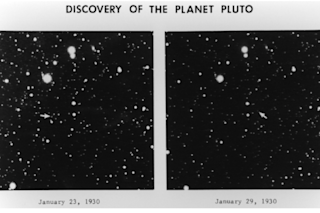Discovery photos of Pluto, taken by Clyde Tombaugh under Vesto Slipher's direction. Now we know that the unassuming dot at the arrows is an exotic world with five moons. (Credit: Lowell Observatory) As the New Horizons probe closes in on Pluto--now less than two days away!--there have been a lot of thoughtful articles looking back at the people responsible for the discovery of this remarkable little world. They have focused mostly on Clyde Tombaugh, the man who spotted Pluto amidst a sea of stars in 1930. Some articles have also told the story of Venetia Burney, the 11-year-old girl who gave Pluto its name, or Percival Lowell, whose obsession with finding "Planet X" inspired Tombaugh's search. In all these stories, though, one name is conspicuously missing: Vesto Slipher. It was Slipher who initiated the planet search and who directed its outcome. He was probably the first to set eyes on ...
The Man Who (Almost) Discovered Pluto...and Also (Almost) Discovered the Expanding Universe
Explore the influential role of Vesto Melvin Slipher in the discovery of Pluto and the expanding universe evidence he provided.
More on Discover
Stay Curious
SubscribeTo The Magazine
Save up to 40% off the cover price when you subscribe to Discover magazine.
Subscribe













